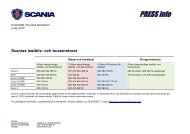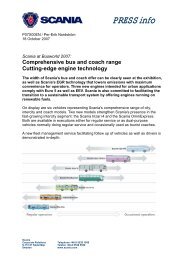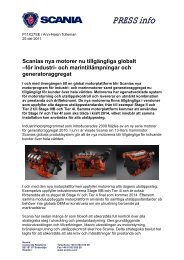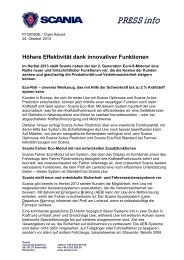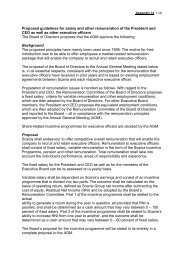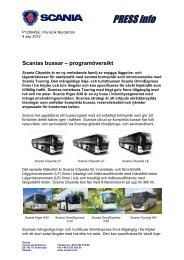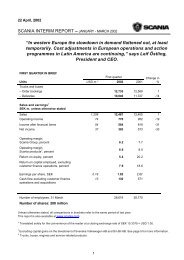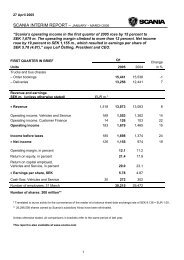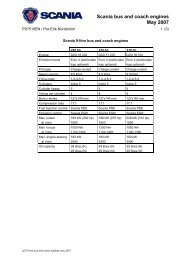Scania annual report 2003
Scania annual report 2003
Scania annual report 2003
Create successful ePaper yourself
Turn your PDF publications into a flip-book with our unique Google optimized e-Paper software.
THE PRODUCTION SYSTEM<br />
The same working methods everywhere<br />
The <strong>Scania</strong> Production System (SPS) is the basis of all production improvement<br />
work. The values, principles and priorities that govern its working<br />
methods are identical, regardless of whether production occurs in Europe,<br />
Latin America or somewhere else in the world. New solutions developed by<br />
an improvement team on the assembly line in São Paulo are introduced<br />
systematically by colleagues at the production units in Zwolle, Angers and<br />
Södertälje.<br />
The <strong>Scania</strong> Production System has been<br />
developed among the company’s own<br />
employees at production units. Other<br />
<strong>Scania</strong> operating units besides pure production<br />
also apply the concepts behind<br />
SPS. <strong>Scania</strong>’s research and development<br />
departments are being streamlined<br />
according to the same principles, and<br />
next in line will be the global service network.<br />
A growing number of <strong>Scania</strong>’s suppliers<br />
are also applying this methodical<br />
way of working.<br />
SPS has contributed to the sharp improvement<br />
in productivity at <strong>Scania</strong> in recent<br />
years. In 1985, the company manufactured<br />
1.6 trucks per production<br />
employee yearly. During <strong>2003</strong>, that figure<br />
had climbed to 4.6.<br />
The <strong>Scania</strong> Production System is based<br />
on four main principles:<br />
Standardised working method<br />
To ensure that <strong>Scania</strong>’s products maintain<br />
high and uniform quality, work processes<br />
have been standardised and documented.<br />
Tasks are performed in a specific way, at a<br />
specific pace and with an even, balanced<br />
flow throughout the production chain. In<br />
SPS, this is called the “normal situation”.<br />
Doing it right the first time<br />
Since work takes place visually, with visible<br />
buffers and process follow-up posted on<br />
bulletin boards, what is normal and abnormal<br />
becomes obvious. Direct feedback to<br />
a person who caused a deviation allows it<br />
to be remedied directly, helping to create a<br />
quality-assured work process.<br />
Consumption-controlled production<br />
<strong>Scania</strong>’s customers decide how many<br />
trucks, buses or engines will be manufactured.<br />
It is also the customer’s order that<br />
determines when production will begin.<br />
This principle permeates the entire <strong>Scania</strong><br />
production chain, from the customer’s<br />
order to the local sales company through<br />
production and assembly through the final<br />
product that is ready for delivery.<br />
Continuous improvements<br />
The overall objective of the <strong>Scania</strong><br />
Production System is to create continuous<br />
improvements, where different production<br />
units around the world can learn from<br />
each other. By continuously discovering<br />
and eliminating waste, the resulting liberated<br />
resources can be applied to other productive<br />
tasks.<br />
More than 1,000 improvement teams<br />
The most important success factor in the<br />
<strong>Scania</strong> Production System is the work of<br />
the various improvement teams. In<br />
<strong>Scania</strong>’s global production system, there<br />
are now more than 1,000 teams, in which<br />
fitters and equipment operators implement<br />
continuous improvements by contributing<br />
their knowledge, professional skills and<br />
capabilities to solving problems. Challenging<br />
and improving the existing processes<br />
is part of the daily work of these teams.<br />
The goal is to find the easiest flow and the<br />
easiest method for each situation in their<br />
daily work. This has greatly increased<br />
employee motivation and job dedication.<br />
SPS Office has key coordinating<br />
function<br />
During <strong>2003</strong>, <strong>Scania</strong> established an SPS Office<br />
to back up and coordinate the continued introduction<br />
of the <strong>Scania</strong> Production System<br />
throughout the Group.<br />
The SPS Office works from the Group’s<br />
head office in Södertälje with the worldwide<br />
<strong>Scania</strong> organisation. The office’s task is to help<br />
bring about a uniform interpretation of the<br />
system’s values and principles throughout<br />
<strong>Scania</strong>. The SPS Office is also responsible for<br />
disseminating knowledge and helping continuously<br />
improve methods and tools, as well as<br />
establishing a standardised SPS working<br />
method. One important task is to transfer<br />
knowledge and best practice between different<br />
units.<br />
Aside from <strong>Scania</strong>’s production units, the<br />
office’s working area includes outside suppliers<br />
and other departments at <strong>Scania</strong>.<br />
The employees of the SPS Office have long<br />
experience and wide-ranging expertise in<br />
such areas as machining, assembly, production<br />
engineering and procurement. This enables<br />
them to deal with a variety of needs at <strong>Scania</strong>.<br />
The back-up role of the SPS Office includes<br />
everything from helping the organisation to<br />
teach production principles to supporting the<br />
introduction of these principles in concrete<br />
improvement projects.<br />
ANNUAL REPORT <strong>2003</strong> 32



